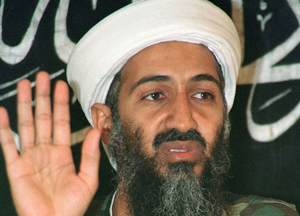
Chidanand Rajghatta
WASHINGTON: A large mansion in a massive compound with 4m to 6m tall walls topped with barbed wire. No telephone or internet connection to the house. And seldom seen residents who burnt their trash rather than dispose it as other neighbours did.
These were the slender leads that eventually took US spooks and seals to the world's most wanted fugitive. Osama bin Laden lived not in a cave in some frontier mountain redoubt, but in a suburban neighborhood in a million-strong city just an hour's drive from Islamabad, right under the eyes of the Pakistani military.
No one is particularly surprised about this. In fact, going by the track record of major al-Qaida and Taliban operatives captured so far, it would seem that images of them hiding in caves are overblown. Most of them have been captured in Pakistani cities -- Khalid Shaikh Mohammed in Rawalpindi, Mullah Biradhar in Karachi, and other operatives in places like Faisalabad and Multan. It would seem the terrorists like their comfort -- or at least they are kept in comfort.
Details of how the US homed in on bin Laden are still sketchy, but this much is known based on what President Obama himself said and background briefings by officials.
Right from the moment he took office, Obama resolved to hunt down bin Laden, a goal that his predecessor Bush (who once suggested he did not want to personalise the bin Laden hunt) appeared to have taken his eyes off from. The new President called in the CIA chief and told him to devote whatever resources were needed to nail bin Laden, even as he shifted the focus from the war on Iraq to the Afghanistan-Pakistan theatre.
Last August or September, the CIA team tasked with the bin Laden hunt succeeded in developing leads obtained from a Guantanamo detainee four years ago about two brothers who had acted as couriers for bin Laden. Their identity was established and then their coordinates.
Tracking then, the US team got to know with some degree of certainty that they were making sorties to a compound in Abbottabad, a military cantonment 60 km north of Islamabad. The design of the compound and the mansion, and the activities surrounding it, indicated it held someone important.
Security meetings
Whether the US knew with certainty it was bid Laden is not clear, but between March 14 and April 28, President Obama held five national security meetings with his top aides to decide on how to approach the problem at a time ties with Pakistan were at all all-time low because of the Raymond Davis episode.
The incident made it all the more dicey to employ American forces for an airborne attack, particularly given past US experience in Iran and Somalia, and the Pakistani military's virulent response to any suggestion of US ground action inside Pakistan, much less at the doors of a military cantonment.
Still, Obama gave the go-ahead for the operation over the weekend. Three or four US choppers carrying elite Navy Seals were deployed on Sunday night/Monday early am. No Pakistani personnel were involved.
The US team ran into resistance. Bin Laden was living in the compound with his eldest son and his youngest wife. The two couriers were also with him. Bin Laden was reportedly shot in the head in a firefight. Two other men and a woman also died. It is not clear if they included his son and wife.
There were other mishaps. A US chopper involved in the attack developed a malfunction at some point and crashed in the neighborhood. This was reported in the Pakistani media several hours before news of bin Laden's death emerged, with no mention of American involvement or the hunt for bin Laden.
Pakistani officials had shut down the area and kept out the media on orders from the US.
Only in the morning in Pakistan, when the wreckage from the chopper (which the US reportedly destroyed) was cleared, did the story emerge that the smoldering house in the Abbotabad suburb had hosted Osama bin Laden. He has been shot and killed by US forces, who had even taken away his body from Pakistan and reportedly removed his remains at sea. - Times of India/Pacific Media Watch



